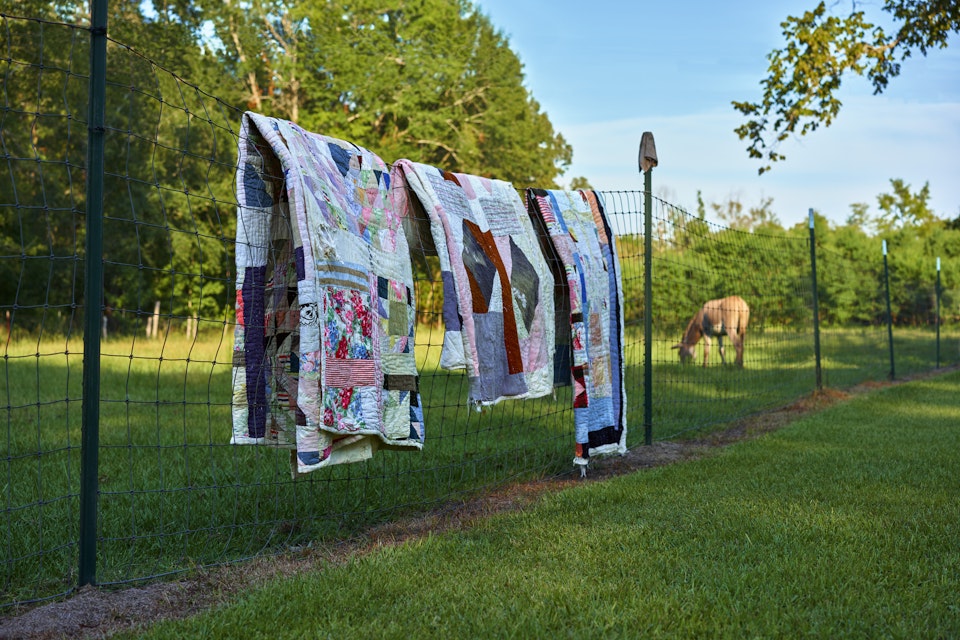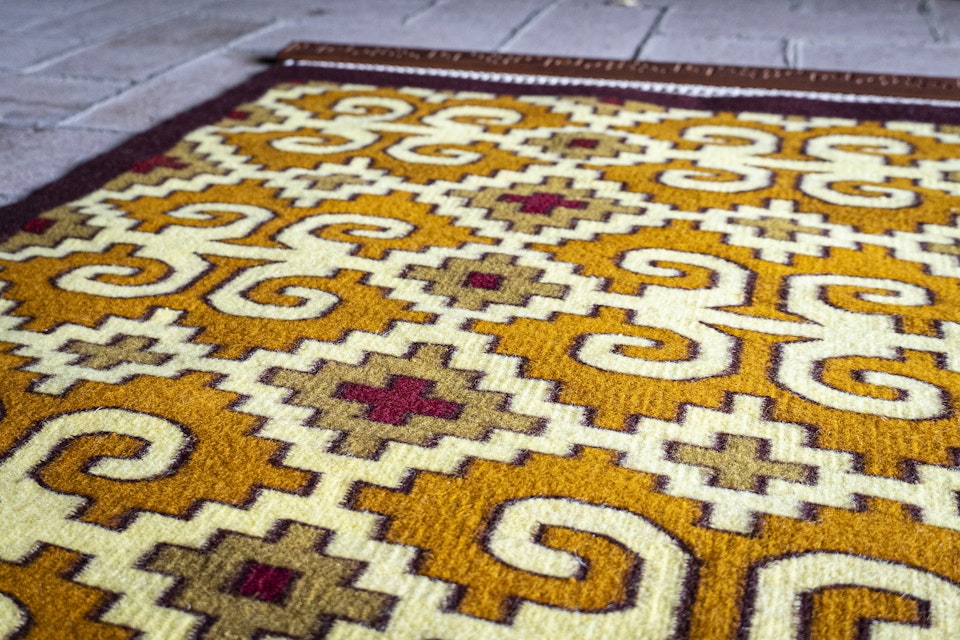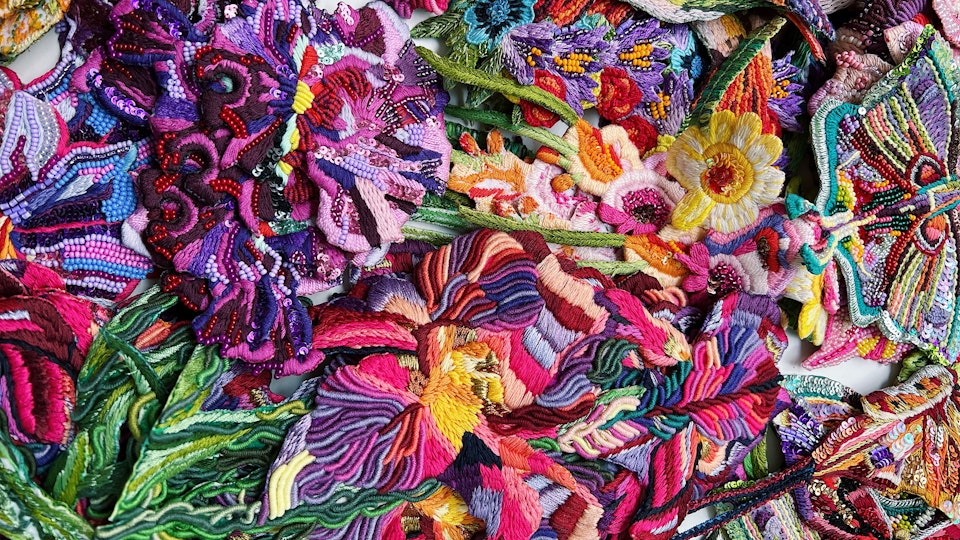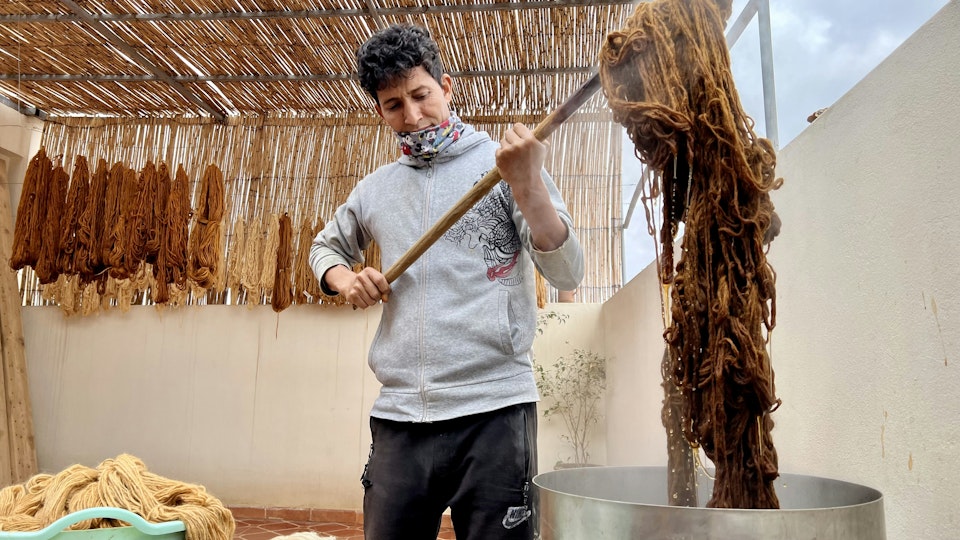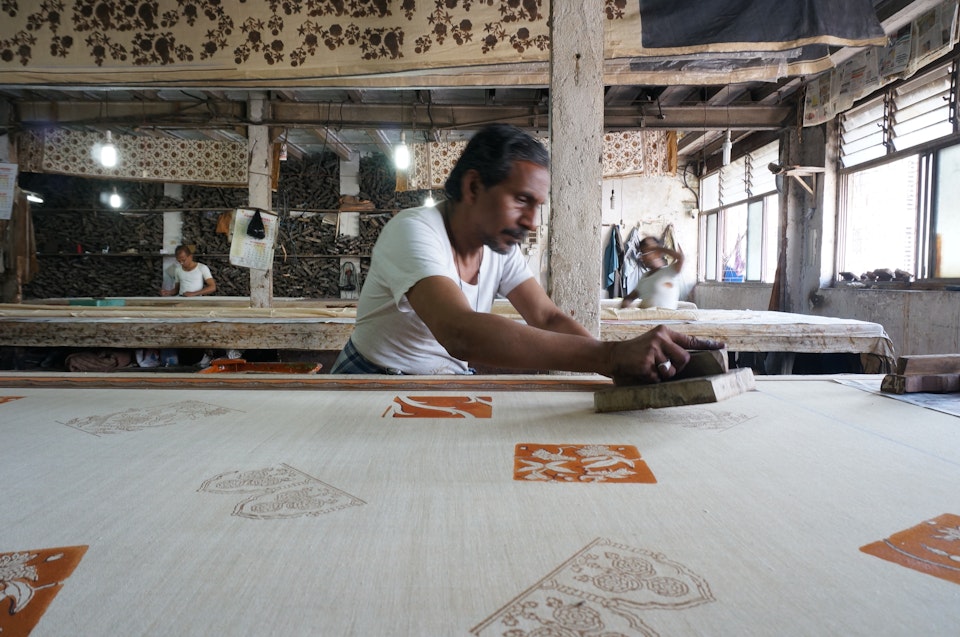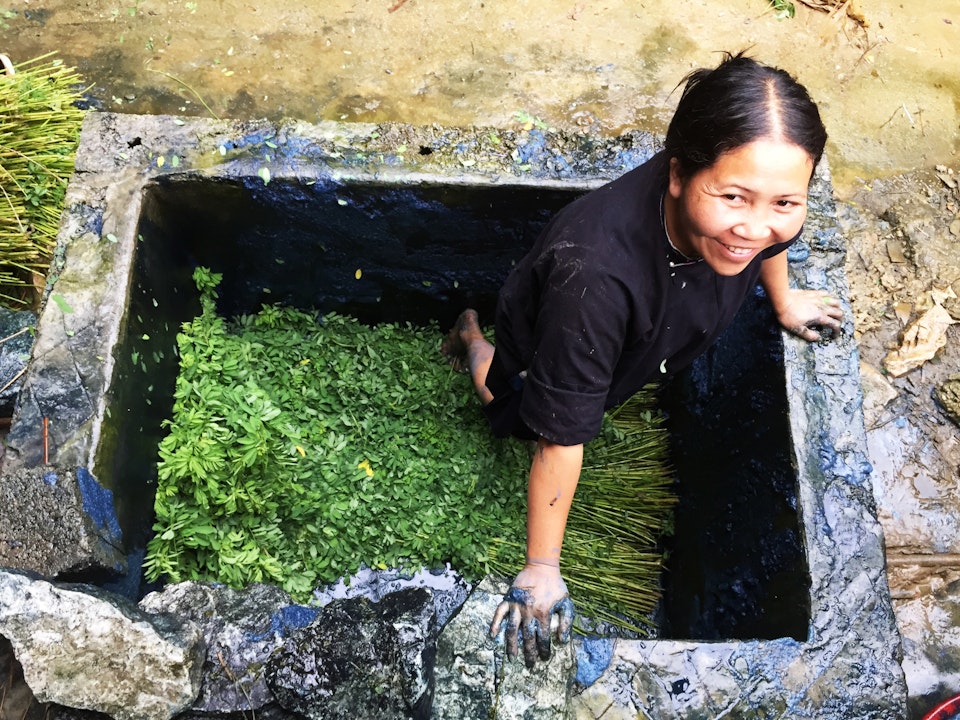July 26, 2024
Rich Heritage Textile Traditions From Around the Globe
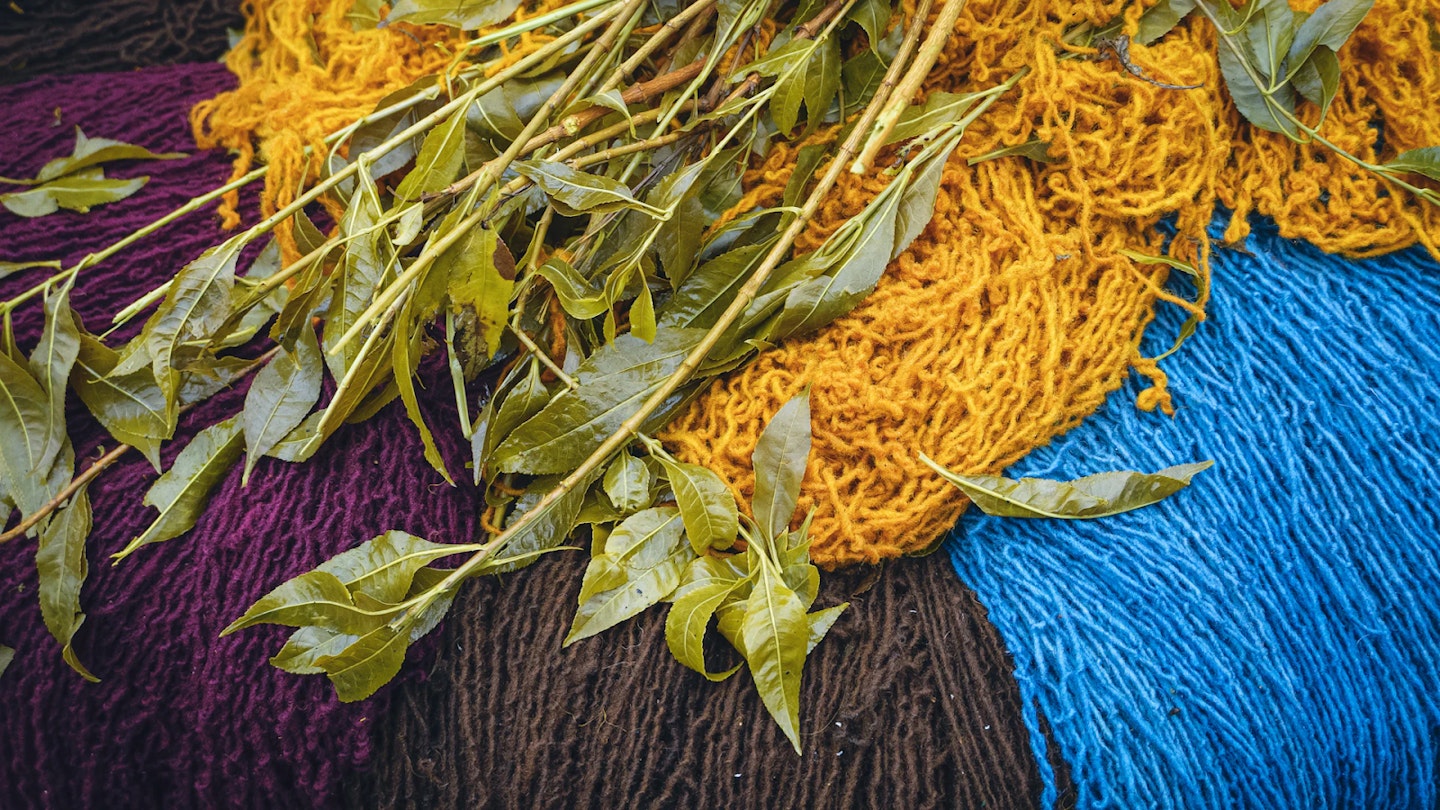
Textiles may be the most immaterial materials on earth. They hold our memories, our desires, our knowledge, and our secrets. Textiles are a thread between humanity’s past and present—containing histories so deep we often take them for granted.
Around the world, textiles are linked to the earliest civilizations and Indigenous intelligence. They are deeply rooted in the DNA of our global artist community. I find them to be a grounding, calming presence: They reassure me that the stories humans want to tell will get told in due time. Textiles are a canvas on which humanity’s yearnings are stylized through color, texture, and technique—becoming physical manifestations of life itself.
Take a look at these fascinating textile traditions from around the globe. They may be even closer to home than you expected.
Textile Traditions of the American South
Laura and Marlene’s house in Gee’s Bend, Alabama, whose quilting tradition is recognized as one of the most important historic art forms in the United States.
Textile experimentation is as American as apple pie. Our best example may be Black American quilting traditions. Through quilting, these women became historians, recording the legacies of their families. The tradition reveals how quilting—as a practice and a physical art form—holds the power of memory.
In Gee’s Bend, Alabama, master quilters Loretta and Marlene host a VAWAA experience. Loretta is a fifth-generation quilter whose roots trace back to Dinah Miller, one of the first enslaved women brought to Gee’s Bend in the early 17th century. The wisdom held in generational quilts like theirs is an encyclopedia of human genius and artistic expression.
Vibrant Backdrops of Zapotec, Mexico
Jacobo creates designs using fine threads made of local creole sheep wool, merino wool, alpaca wool, and even silk, gold, and sliver threads.
Traditions may be a set of collectively accepted rules and customs—but no one ever said tradition couldn’t evolve to fit new molds. Jacobo, a master weaver and VAWAA artist in Zapotec, Mexico, has taken textile traditions to new heights with his intensely colored wool rugs. He learned the trade from master weavers like his father, Don Emilio, starting from age 8, and began his journey to mastery through the fundamentals of slow textile creation, with Oaxacan traditions as his anchor.
Jacobo experiments with vegetable dyes and alternative fibers like silk, gold, and Creole sheep wool. His complex designs encapsulate everything from the Zapotec ecosystem. He extracts pigments from flowers and insects, creating works with incredible precision: 20 to 45 threads per square inch. (The average is around five threads per inch.) Using the “greca” geometric shapes of the Oaxacan Zapotecs, his art exemplifies the concordance of life and tradition—connecting the generational beliefs of textile weavers.
Intricate Stitching in Medellín, Colombia
Ana Maria collaborates with traditional Colombian artisans to create exquisite, one-of-a-kind garments.
In Medellín, everything is vibrant. From gastronomy to textiles, the artistic pulse of the City of Eternal Spring is perpetually beating.
Ana Maria, a VAWAA host and Colombian textile designer, invites the artist in you to join in the passion of Colombian culture. As a textile artist, Ana Maria marries ancient Colombian embroidery techniques and contemporary fashion to craft a style that is wholly unique. She’s created pieces for British royals, but her wearable textile art is down-to-earth: It reminds us that there is beauty in the everyday. Her most impressive works include hand-beaded foliage and silk embroidered exotic animals that recall the Andes’ natural beauty and traditional clothing.
Traditional Henna Dyes in the Moroccan Foothills
Ahmed’s early years as a nomad in the Atlas Mountains fuel his love for ancestral lands and natural dyes.
Traditional Moroccan rug making is an act of humility. These artists honor land and the master rug makers that came before them—many of them women. The history of Moroccan rugs is deeply entrenched in heritage and sustainability. Crafted mainly by the women of Amazigh (Berber) tribes, these intricate rugs were handmade to withstand the climates of the Atlas Mountains and the Sahara. Moroccan rugs have an ancestral quality: They feature wool spun into intricate glyphs of the Ottoman, Arab, and Roman empires.
Fadma and Ahmed, VAWAA artists and Moroccan culture connoisseurs, invite you to discover and share the textile traditions of their ancestors. Fadma, whose specialty is the Berber knot, heads a cooperative of more than 70 Amazigh weavers; she is reinvigorating what a sustainable career looks like for Moroccan craftspeople. Her partner Ahmed’s early years as a nomad in the Atlas Mountains fuel his love for ancestral lands and natural dyes—he’s developed more than 60 unique hues from his colored-dye experiments. Their partnership honors the past and tells the story of Morocco’s rich textile history.
Block Printing in India
Sarfraz Khatri is a sixth-generation ajrakh block printing artist, a 13-step printing technique that has roots in ancient Indian culture.
India is the world’s largest exporter of block-printed fabrics. These meticulous prints date back to the Indus Valley civilization in 3,500–1,300 B.C., and continue to carry the legacy of India’s rich textile history. Primarily made of cotton, Indian block prints display a range of motifs in colorful dyes. The designs are elaborately hand-carved in softened sycamore or teak woods, then dipped in pigments to create world-renowned textiles.
VAWAA artist Sarfraz, a sixth-generation block printer, has perfected the traditional 13-step hand block printing and dyeing technique. His work draws from a number of cultural treasures seen around Mumbai. These block prints are a looking glass into the past for the contemporary soul.
Indigenous Dyeing in Vietnam
Vu Thao is a clothing designer who seamlessly merges contemporary silhouettes with traditional Vietnamese techniques.
Vietnamese dyeing history is said to span back to Medieval times, and the descendants of Vietnam’s many Indigenous groups have preserved their stories through textiles. Indigo, one of Vietnam’s most coveted pigments, grows from the Indigofera plant and is the starting point for traditional Vietnamese attire. The process of creating the perfect indigo hue, however, takes about a month. After its fermentation and powdering process, textiles are dipped repeatedly to obtain the deepest-possible indigo color. It’s a ceremonial process, honoring the land and the artists’ ancestors who practiced the same techniques millennia ago.
Thao, VAWAA artist and contemporary clothing designer, has meshed the techniques of indigenous Vietnamese women and with her artistry to platform textile practices that are at risk of being forgotten. In collaboration with the women of the Northern mountains of Vietnam, Thao continues to center ancient textile traditions and sustainability.
Nature-Inspired Textiles in Hokkaido, Japan
Koko’s art unravels the secrets of textiles, highlighting the connection between hand and place.
Japan’s early textiles were a labor of love, the result of foraging from local plants and trees known as bast fibers. This ancient philosophy of sustainable sourcing is where Koko’s artistry is rooted. A Japanese textile designer and VAWAA artist, Koko has taken the natural wonders of her home into the heart of her work. Using natural materials (like discarded wool from local sheep) from the highlands of Hokkaido, Koko’s weaved images are a reflection of the region.
From tapestries to abstract artworks, Koko brings to life the immaterial—the smells of the Hokkaido flowers, the wind rustling against towering trees. Through her textiles, we feel the essence of Hokkaido and what it means to be resourceful in our artistry.
Written by Tyler Pharr
Explore all mini-apprenticeships, and be sure to come say hey on Instagram. For more stories, tips, and new artist updates, subscribe here.
